Shep Hyken's Blog, page 80
August 6, 2021
Guest Post: Top Benefits of Outsource Call Centers
This week we feature an article by Charlotte Blackmore, an SEO Executive and content creator based in Essex. She writes about how using an outsourced call center can be a successful strategy for keeping customers happy.
One of the most effective ways of growing a business is through streamlining your customer communications. Providing a quality experience for your customers has a positive impact on generating increased sales and improving overall brand reputation. This job can sometimes prove to be difficult, especially when you are trying to manage your multiple business functions at once. Fortunately, there are plenty of helpful solutions available which can take this task off your hands! For example, using an outsource call center is a successful strategy for keeping customers happy and ensuring your business achieves the results it hoped for.
If you’re interested in choosing this method and would like to know more, we’re going to be focusing our article on the top benefits of outsourced call centers. So, you can explore all the ways in which an outsource call center works and why you should consider it.
Take a look!
Reduced CostsBy finding an outsource call center to manage your customer services, you’ll be able to avoid those extra costs for employee equipment, training, and facilities that are involved with in-house teams. Outsource call centers also provide cost-effective alternatives to suit your budget requirements, with the option to pay for services on a transactional or per-hour basis. It also saves money associated with running customer services in-house. Such as hardware, software, desks, and management which staff would require.
Outsource call centers already have state-of-the-art technology in place to run these operations for you. As well as handle the hiring of staff to ensure your business is assigned with an expert customer care team. So rather than spending more money to employ someone which quickly adds up, why not pay less for an outsourcing company to do the same hours?
Maximized TimeA great thing about having an outsource call center is that it saves the hassle of setting up a system in-house and securing the right staffing to do the job. This means it offers greater time and flexibility for you to focus on the other aspects of your business such as dealing with new clients or sorting production. So you’ll never have to worry about being available or missing those important project deadlines!
If you have staff in-house, this means more of your time is taken up with monitoring their performance and keeping the team organized. Whereas an outsource call center covers this for you so you can free up your schedule! Making it easier to target qualified prospects and drive new leads without using your business time.
Improved PerformanceOutsourcing is a useful way of building your business’s workforce as all the hiring and training is done for you. An outsource call center has highly trained experts available suited for all types of industries as they focus on recruiting the best-experienced professionals. This means getting individuals with the right level of skills and expertise to engage with your customers and understand processes quickly.
By having the ideal talent that matches your business requirements, you can ensure the best quality service is delivered to your customers. It also allows you to get the most out of your tasks and achieve higher quality results whilst improving efficiency.
Transparent ResultsGetting the right driving force behind your sales process is a vital practice in growing your customer base. Fortunately, an outsource call center has the tools to facilitate this whole task for you and ensure your sales go in the right direction. To keep track of progress, outsource call centers communicate between both parties to share project insights and provide clear transparency. Additionally, outsourced call centers have the latest technologies to collect real-time data for reporting and analysis. These strategies are helpful for quality monitoring, controlling processes, and improving customer satisfaction.
Greater FlexibilityWith an outsource call center, 24/7 customer support solutions are provided and are completely tailored to your needs so no matter where or when you have to open, outsourcing providers can offer their core services around the clock. Their workers will also have different shifts to cater to specific time zones and regions. In addition, outsourcing teams have the infrastructure to dedicate their full time to meet your unique objectives. So, if your business wishes to change call volumes or increase activity for a new campaign, outsource providers offer flexible operations to suit all clients’ needs.
It’s clear outsourcing can make a positive difference to many parts of a business. From cutting internal overhead costs, leveraging your customer base to saving time for performing other key activities. When it comes to investing in an outsource call center, companies can automate processes and achieve greater productivity whilst reducing overall expenditure. Whether a business hopes to accelerate functions or simply build efficiency, outsource call centers cover all areas!
Charlotte Blackmore is a professional SEO Executive and content creator based in Essex, who loves helping businesses grow online.
 For more articles from Shep Hyken and his guest contributors go to customerserviceblog.com.
For more articles from Shep Hyken and his guest contributors go to customerserviceblog.com.
Read Shep’s latest Forbes article: Your Customers Crave Information
The post Guest Post: Top Benefits of Outsource Call Centers appeared first on Shep Hyken.
August 4, 2021
Would You Rather Go to the Dentist or Call Customer Support?
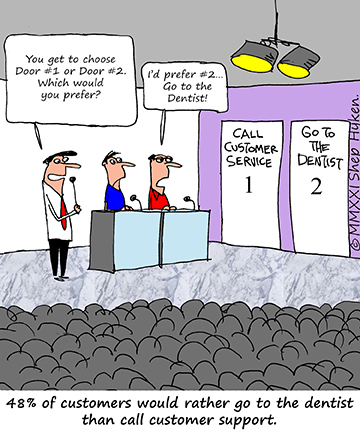 Here is a stat that’s hard to believe:
Here is a stat that’s hard to believe:
Forty-eight percent of Americans would rather go to the dentist than call customer support.
OUCH! It seems that going to the dentist to get a filling or a root canal is preferred over having to call customer support. This statistic comes straight from the 2021 Achieving Customer Amazement Study we conducted this year. We surveyed more than 1,000 consumers to find out what they loved and hated about customer service. What would make them come back or terminate their relationship with the brand or company? But let’s get back to this stat for a moment.
The following horror story has happened to all of us.
You spend 10 minutes searching a company’s website for a customer support phone number that you eventually find in tiny print on an obscure page. You make the call and you’re put on hold for an unreasonable amount of time. The hold music is terrible, and they don’t tell you how long it’s going to be. You just wait and wonder. Someone finally answers. You have a hard time understanding them. It may not be an accent that’s hard to understand. It may be that you can hear hundreds of other customer service agents in the background, making it hard to hear the agent you’re talking to.
You take the time to tell the agent your name, address, last four digits of your Social Security number, your mother’s maiden name, and the answer to a security question. Then another five minutes explaining your story. The agent keeps saying, “I’m sorry,” so many times that it loses its impact and seems insincere. You hope this is the person to help you, but your dreams are shattered when the agent says, “I’m sorry, that’s not my department.” From there they transfer you to someone they think is better equipped to help you.
And, then it starts over! The next agent and the experience is no better than the last. Finally, you ask to speak to a supervisor. Yes, you’ve done that! Admit it! I can keep going, but you get the idea.
First, nobody wants to call customer support. They don’t want to have a problem that forces them to do something they hadn’t planned on doing. But it happens, and when it does, you can’t give your customers anything that resembles the experience I just described.
So, do you want to know what’s important to customers? Here’s a peek at some of the findings from the ACA study. Customers want:
employees who are knowledgeable about the products and services a company sells employees who are kind and helpful the ability to reach the right customer support person convenience – an easy and hassle-free experience fast responses to their customer support questions from an email, message, or textThese are some of the basics! And to most of us, these are common sense. Unfortunately, they aren’t always as common as they should be. But the companies that get it right flourish ahead of the customer service laggards. Read more stats and facts in the 2021 ACA study that will help guide your decisions as you improve your customer service. The information the survey revealed is your motivation to deliver an amazing customer experience.
Shep Hyken is a customer service expert, keynote speaker, and New York Times, bestselling business author. For information on The Customer Focus customer service training programs, go to www.thecustomerfocus.com. Follow on Twitter: @Hyken
customer service training programs, go to www.thecustomerfocus.com. Follow on Twitter: @Hyken
(Copyright © MMXXI, Shep Hyken)
The post Would You Rather Go to the Dentist or Call Customer Support? appeared first on Shep Hyken.
August 3, 2021
Amazing Business Radio: Ray Wang
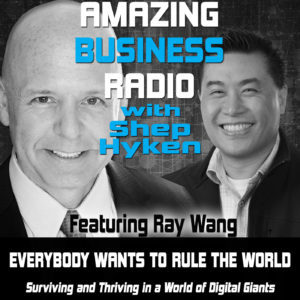 Everybody Wants to Rule the World
Everybody Wants to Rule the WorldSurviving and Thriving in a World of Digital Giants
Shep Hyken interviews Ray Wang, Principal Analyst, Founder, and Chairman of Silicon Valley, based Constellation Research, Inc. They discuss Ray’s book, Everybody Wants to Rule the World: Surviving and Thriving in a World of Digital Giants, a groundbreaking guide that reveals which companies will thrive and get crushed by the powerful forces now at work.





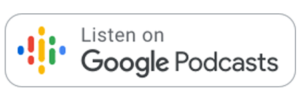

Top Takeaways:
– The biggest insight is that the companies that figured out how to win have actually increased their gap with everybody else. It’s like they’ve left the other companies in the dust.
– Do you have a digital business model? Do you understand how you build a business around that? And do you have digital monetization? And then, of course, are you focusing on delivering an excellent customer experience?
– Customers are trading loyalty for convenience, status, and value. This is even more important as we advance because brands that don’t understand loyalty and community will be dead in the water.
– In the middle of the pandemic, we set off this ultimate collection of autonomous data collection and information/insights that actually drive signal intelligence. And that refinement of that information insight is creating competitive modes for organizations that know how to use data. Brands and companies can now predict what you might like, prevent fraud, mitigate risk, or identify a new market that hasn’t been touched.
– Mass personalization happens in places all around us. So we’ve gone from transactional systems like CRM to engagement systems that are really like social business to experiences, which is about using technology and AI to craft journeys that deliver mass personalization at scale.
– You have to go out and find your turnaround catalysts. Reinvent your board to start thinking long-term, so they can compete, not on the short-term quarter to quarter EBITDA (Earnings Before Interest, Taxes, Depreciation, and Amortization) cycle, but long-term in thinking about dominating and building your digital giant.
Quotes:“Customers are trading loyalty for the price, convenience, status value, and any other reason. We don’t see it ending, but we see an evolution where loyalty is part of a larger equation around relevance and value exchange.”
“The pandemic changed the way we look at real-time information and real-time insights. In fact, in the digital world, every action we take is a demand signal.”
“If I don’t have any competitors, I’m going to get stagnant.”
About:R “Ray” Wang is the Principal Analyst, Founder, and Chairman of Silicon Valley, based Constellation Reseach, Inc. He is the co-host and co-founder of the widely watched DisrupTV, a weekly enterprise tech and leadership webcast.
Shep Hyken is a customer service and experience expert, New York Times bestselling author, award-winning keynote speaker, and your host of .
This episode of Amazing Business Radio with Shep Hyken answers the following questions … and more:
What is a digital business model?What is digital monetization?How does a business with a customer-centric point of view look?What is mass personalization?Why is monopoly terrible for our economy?The post Amazing Business Radio: Ray Wang appeared first on Shep Hyken.
August 2, 2021
5 Top Customer Service Articles of the Week 8-2-2021
Each week I read many customer service and customer experience articles from various resources. Here are my top five picks from last week. I have added my comment about each article and would like to hear what you think too.
Customer Experience Strategies to Annoy or Delight Your Customers by Phil Britt(CMSWire) Let’s be frank: no company goes out of its way to produce miserable customer experiences. And yet, they happen. Any strategy a company takes is one it believes will improve customer experience (CX). But often what a company thinks the customer wants is different from what they in fact want.
My Comment: What do you do that annoys your customers? Here are three ways to do so along with some “crowd-pleasing” strategies. The article starts with the idea that often we think we know what our customers want, but what they actually want is different.
Three Surprising Facts About Customer Experience by Brad Cleveland(Forbes) Customer experience encompasses far more than your products, customer service, technologies, processes, and culture. It’s all those things — and more — and how they work together. It’s big. But it’s also the latest, even seemingly insignificant interaction you had with a customer.
My Comment: There is a theme to the first two entries in this week’s Top Five roundup. One of the three “surprising facts” is the disconnect between what leadership thinks about their CX and what customers think. Okay, not a surprise anymore. You’ll have to read the article to get the other two.
9 Actionable Tips For ECommerce Multichannel Marketing by Nick Shaw(CustomerThink) In a world where smartphones are ubiquitous and 76% of adults living in advanced economies have a world of information at their fingertips, it should be no surprise that the future of marketing lies in tapping into the customer’s online experience.
My Comment: In the eCommerce world, our customers are using multiple channels to connect with us. The article starts off with some stats and facts about why consumers unfollow brands. It then shares nine tips to create a better experience for your customers which will help keep them and nurture them into becoming repeat customers.
What Does Customer Loyalty Mean For Your Business? by Syrow Editorial Team(Syrow) Customer satisfaction is about how your customers feel about your brand or offerings. Customer loyalty, on the other hand, is the attitude that ensures your brand’s “stickiness” and keeps customers staunch over time.
My Comment: The article starts with the popular Walt Disney quote: “Do what you do so well that they will want to see it again and bring their friends.” (I love that one!) The gist of the article is about the difference between satisfied customers and loyal customers. The author shares their favorite measurement tools and why they may help you measure more than just customer satisfaction.
Why Messaging is the Gateway to Great Customer Experiences by Tristan Gadsby(Hospitality Net) Developing relationships is the heart of hospitality and technology will never replace the fundamentals, however, the COVID-19 pandemic has brought forward the need for contactless technologies.
My Comment: Messaging customers important information is another way to create a better experience. Customers love communication. It gives them a feeling of control and confidence. While this article focuses on messaging in the hospitality industry, there are ideas that can cross into almost every industry.
Shep Hyken[image error] is a customer service expert, professional speaker, and New York Times bestselling business author. Go to The Customer Focus to learn more about our customer service training programs. Follow on Twitter: @Hyken
to learn more about our customer service training programs. Follow on Twitter: @Hyken
The post 5 Top Customer Service Articles of the Week 8-2-2021 appeared first on Shep Hyken.
July 30, 2021
Guest Post: Tips to Boost Client Satisfaction in the Post-Pandemic Era
This week we feature an article by Nathan Liao, the founder of CMA Exam Academy. He writes about how businesses can be more successful by implementing changes that will boost client satisfaction.
Social distancing regulations have ended in many areas, people are booking up their social calendars with events, airports are once again filled with excited travelers… it seems like the COVID-19 crisis is starting to become a thing of the past. Now that we are entering a new post-pandemic era, it is time to sit and brainstorm how you can make your enterprise more successful. One way to do that is by implementing changes that will boost client satisfaction.
Your current and potential clients are now looking to spend their money on themselves and make changes in their businesses. They could be in the market for the services that you offer, so you must ensure they are nothing short of satisfied with the experience that you provide. If your customers are not fully happy with your company’s services, they may consider taking their business to one of your competitors. You definitely don’t want that to happen, so you need to strive to enhance client satisfaction. Here are a few ways to do just that.
Foresee What Your Clients NeedOne surefire way to really enhance client satisfaction is to anticipate what your customers may need from you in this post-pandemic era. Take a moment to consider how their lives or businesses are changing and how your services can help them during this time. If you are proactive and go above and beyond your clients’ usual expectations, they will really appreciate the extra effort and feel like you truly care about their well-being.
There are many ways you can do this. For example, if you own a financial services company, you can send an email with helpful tips on planning a post-pandemic budget to all of your business clients. Or, if you own a consulting firm, you may foresee your clients wondering how to improve team collaboration in a hybrid workforce. Take initiative and put together a helpful how-to video to send to your clients before they even ask you for advice. And if you do not know what your clients may need, go ahead and ask them! They will really appreciate the effort.
Improve Your Inquiry Response TimeIsn’t it frustrating when you are left on hold when calling a company’s customer service line? So why would you make your clients wait days for replies to their phone calls or emails? Yes, the days always get so busy and filled with urgent tasks, but you should do what you can to reply to your clients’ emails and calls quicker. After all, they are the ones who are keeping your enterprise afloat! Replying to inquiries quicker is sure to boost client satisfaction.
There are various ways you can improve your inquiry response time. First, you can schedule one hour each day just to reply to calls and emails from the last 24 hours. If you simply cannot find the time, hire a virtual assistant who can reply to all incoming emails right away and answer general questions. Also, you can set up an automatic reply to all incoming emails that lays out when your clients can expect a reply from you. The email can say something along the lines of “Thanks for reaching out! Please expect a reply by tomorrow.”
Provide Consistent Status UpdatesAs a business owner, you don’t want to leave your clients wondering where things are at in the projects and work they’re paying you for. That said, you will really boost their satisfaction with your services if you provide regular status updates without them having to ask you for them. For example, if you’re working on a long-term project for a client, send a daily or weekly check-in email that discusses what has been done and the next task at hand. Be consistent with your status updates so your clients know you really care about the projects you’re doing for them.
Introduce New Services They NeedIf your clients have inquired about a service you don’t yet provide, see what you can do to start offering it. This will help prevent them from possibly bringing their business to one of your competitors who do offer the service your business lacks. To start providing the service, you may need to pay for online courses or take an exam to get a certification, but it will definitely be worth it! Your current clients will be happy that you now offer the new service and it can open up the door to a whole new market of potential clients looking specifically for that service.
To Wrap It All UpClient satisfaction will be paramount in the post-pandemic era. Now that society is opening up, your current and potential clients may need your services for the changes they’re making in their lives and businesses. Make sure to boost client satisfaction by anticipating what they need, replying to their inquiries quicker, and providing regular status updates on projects. Also, get certified or take an online course that will enable you to start offering a whole new service your clients need. These steps will enhance your clients’ satisfaction with your company.
Nathan Liao is the founder of CMA Exam Academy. As a CMA and CMA coach, Nathan mentors accounting and finance professionals in over 80 countries to earn their CMA certification in as little as 8 months.
 For more articles from Shep Hyken and his guest contributors go to customerserviceblog.com.
For more articles from Shep Hyken and his guest contributors go to customerserviceblog.com.
Read Shep’s latest Forbes article: Another Way To Lose Your Customer
The post Guest Post: Tips to Boost Client Satisfaction in the Post-Pandemic Era appeared first on Shep Hyken.
July 28, 2021
The “Always” Concept: What We Must Always Do For Our Customers
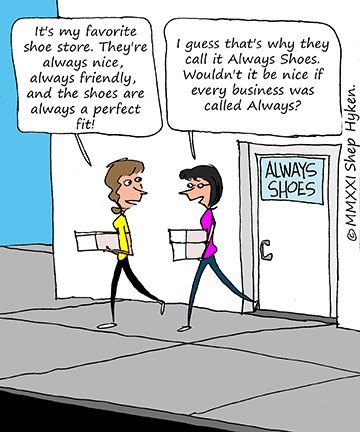 One of the big concepts we teach in our customer service training programs is the concept of Always. This is the backbone of creating customer amazement. When the customer uses the word always followed by something positive, you are creating a predictable experience, and even more important, you are operating in the zone of amazement. For example, your customers might say:
One of the big concepts we teach in our customer service training programs is the concept of Always. This is the backbone of creating customer amazement. When the customer uses the word always followed by something positive, you are creating a predictable experience, and even more important, you are operating in the zone of amazement. For example, your customers might say:
Notice that these statements are about the interactions customers have with your employees. Often, they are really just one person the customer is interacting with. So, consider the following questions:
What always happens when customers do business with you? What are the words your customers use to describe their experience with you? It’s nice when they use descriptive words like friendly, knowledgeable, helpful, etc., but is the word always in front of them? In other words, is the customer service and experience you provide consistent and predictable?Sounds simple, doesn’t it? But simple doesn’t mean easy. Let’s talk about what drives the Always experience. It’s really two words: people and process.
It starts with the right people, whether they are newly hired or have been with your organization for years. Your people must understand what is expected and what drives the experience you’re trying to provide. Beyond understanding, it takes training – and not just one time. It’s ongoing reinforcement of the goal for the customer experience you want to provide. Training can be just a few minutes each week at a weekly team meeting. Some organizations have daily meetings where customer service and experience are brought up, even if just for two or three minutes. The point is that it is never a distant memory.
Then there is the process you provide. While the always statements above mostly apply to the people, you also want to have a good customer-focused process to support it. The journey the customer takes must be easy. Ideally, you want your customer to say, “They are always easy to do business with.” Being easy is baked into the process.
So, have a team meeting. Discuss the concept of Always. Discuss your answers to the questions above. The Always concept drives trust, and trust is a big reason why customers come back to do more business with you. Do it right by creating an experience that ensures customers always come back!
Shep Hyken is a customer service expert, keynote speaker, and New York Times, bestselling business author. For information on The Customer Focus customer service training programs, go to www.thecustomerfocus.com. Follow on Twitter: @Hyken
customer service training programs, go to www.thecustomerfocus.com. Follow on Twitter: @Hyken
(Copyright © MMXXI, Shep Hyken)
The post The “Always” Concept: What We Must Always Do For Our Customers appeared first on Shep Hyken.
July 27, 2021
Amazing Business Radio: John Wass
 Choose Your Customers
Choose Your CustomersHow To Compete with the Digital Giants
Shep Hyken interviews John Wass, CEO of Profit Isle. They discuss how companies can identify and focus on their most profitable customers.







Top Takeaways:Businesses need to know which customers are most profitable for them and what value they can offer that makes them unique.It is critical for brands to choose the customers that their business model, team, and company DNA engages with the best. This is their biggest profit opportunity.Identify your most profitable customers and ask, “Am I spending most of my time and resources there?” Also, consider the opposite. Ask, “Am I distracted with customers that don’t make me a lot of money that I’m neglecting my best customers?”Companies need to decide which subset of customers brings in the most profit and become more customer-centric with them.Not all revenue is good revenue. Not all customers will bring more profit to your bottom line. Have the conviction to walk away from some of the revenue that is actually costing you money and profits.Quotes:
“The customer is always right. But not every customer is right for you.”
“The fastest way to make money is to sell more to the customers who already love you.”
“Companies need to identify what they can uniquely bring to the market, communicate it clearly to their customers, and spend their resources towards it.”
About:John Wass is the CEO of Profit Isle. He was an early member of the management team that grew Staples from three stores to over 1,000 nationwide. He is also a successful entrepreneur who has co-founded and been the CEO of three startups after Staples.
Shep Hyken is a customer service and experience expert, New York Times bestselling author, award-winning keynote speaker, and your host of Amazing Business Radio.
This episode of Amazing Business Radio with Shep Hyken answers the following questions … and more:
What does “choose your customer” mean?How do you choose your customers?How can companies compete with digital giants like Amazon and Facebook?What are the keys to running a customer-centric business? How do you know which customers are most profitable?The post Amazing Business Radio: John Wass appeared first on Shep Hyken.
July 26, 2021
5 Top Customer Service Articles of the Week 7-26-2021
Each week I read many customer service and customer experience articles from various resources. Here are my top five picks from last week. I have added my comment about each article and would like to hear what you think too.
Negative Employee Experiences Can Translate Into Poor Customer Service, Report Says by Emilie Shumway(HR Dive) Dissatisfied employees were more than 2.5 times more likely to say they do not provide excellent customer service and twice as likely to say they do not deliver quality outcomes.
My Comment: We start this week’s Top Five roundup with an article focused on why a focus on the internal customer experience is important to delivering a better external customer experience. Consider the opening stats. “Sixty-four percent of U.S. workers surveyed by consulting firm Eagle Hill said that the employee experience impacts their ability to serve customers. Dissatisfied employees were more than 2.5 times more likely to say they do not provide excellent customer service and twice as likely to say they do not deliver quality outcomes.”
How to Build Customer Loyalty with a Thank You Page by Thomas Griffin(Business 2 Community) While it’s far better to add a thank you page than to simply create a confirmation message, most thank you pages are not optimized as they should be, making for missed opportunities to build your brand.
My Comment: In the digital world, it’s not uncommon to make a purchase and then be directed to a page that thanks you for your purchase. Nice customer service, but don’t miss the opportunity to turn that thank you into the next opportunity. More than just saying, “Thank you,” you can share more product information, get the customer to subscribe to your blog, upsell and cross-sell, ask for reviews, and more.
Lessons from the pandemic can improve your customers’ experiences by Joyce Kim(Fast Company) As we move closer to recovery in the U.S., and hopefully soon, worldwide, it’s important to recognize the lasting impact the last year has had on consumers and how we can use these learnings to inform our business strategy going forward.
My Comment: In the pandemic, we were forced to adapt and adopt new ways of doing business. This article highlights several lessons learned, and my favorite suggestion is at the end when the author suggests that as tempting as it might be (because it is easier), “Fight the urge to go back to the way things were.”
15 Ways To Leverage AI In Customer Service by Forbes Business Council(Forbes) From gathering data to speech recognition and message response times, AI can enhance the customer experience in nearly every way when it’s applied correctly. Here, 15 members of Forbes Business Council share their expert insight on how organizations can leverage AI to enhance their customer service.
My Comment: The Forbes Business Council serves up 15 ideas about using AI to create a better experience. There is something here for everyone, from a small business dabbling with AI to the major brand using AI to leverage insights that drive CX.
What is Customer Retention? (+ 8 Customer Retention Strategies) by Madeleine Wilson(Business 2 Community) While customer acquisition, ratings and reviews, and social proof are the most externally visible success indicators for your brand, customer retention is an integral part of the health of your organization.
My Comment: Reading surveys and feedback from our customers tells you if you’re doing a good job. When you get customers to come back, you know you’re doing a good job. Customer retention is the first step in creating a loyal customer. I enjoyed this article, which features eight strategies that get your customers to come back.
BONUSFive Contact Center Innovations That Are Reshaping Customer Service by Kendal Rodgers(Edify) When agents are better supported, they are better able to deliver better experiences to customers, which is incredibly important in today’s crowded marketplace. Here are five contact center innovations that directly impact agents and are reshaping the future of customer service:
My Comment: Besides the fact that one of my cartoons was shared in this article, I enjoyed this article that focus on the innovations in the contact center. Even if you don’t have a large contact/customer support department, you will get something out of this article, especially the first section which highlights just how important and skilled someone on the front line needs to be.
Shep Hyken[image error] is a customer service expert, professional speaker, and New York Times bestselling business author. Go to The Customer Focus to learn more about our customer service training programs. Follow on Twitter: @Hyken
to learn more about our customer service training programs. Follow on Twitter: @Hyken
The post 5 Top Customer Service Articles of the Week 7-26-2021 appeared first on Shep Hyken.
July 23, 2021
Guest Post: How to Use an LMS for Employee Skill Development
This week we feature an article by Ehsan Memari, a blogger for SkyPrep. He writes about how using a learning management system (LMS) expedites employee skill development in your organization.
We are in the middle of a skills gap crisis. According to a study from the Society for Human Resource Management, 83% of HR professionals noticed a decline in the quality of job applicants, with one-third citing a lack of technical abilities.
On the other hand, around 40% of workers who leave companies voluntarily list poor career growth as a key factor. Therefore, teaching employees new skills is important as it can help improve retention and turnover rates as well as ensure better productivity.
Using a learning management system (LMS) is a cost-effective, more feasible way to expedite employee skill development in your organization. Here’s why:
Offers Collaboration Tools that Improve TeamworkMost online employee training software includes collaboration tools such as file sharing, discussion groups, and virtual meetings. These interactive features provide a forum for employees to discuss requirements, work schedules, and other project needs.
Most LMS platforms also enable workers to collaborate from a distance, so groups that are dispersed can still work as one unit. Relying on one another builds trust and helps every team member learn how to achieve multipart goals with others.
Inspires Creativity via Discussion Forums and FeedbackCreativity is a key quality that makes you stand out in your industry. Many employee training platforms include features such as whiteboards that allow users to build off of one another’s ideas with the help of notes, sketches, and diagrams.
By taking the conversation beyond verbal words or written text, workers can explore new options and ideas by fostering creativity through visualization and inspiration. Moreover, they can share feedback with one another and brainstorm ideas together.
Improves Critical Thinking with SimulationsMany LMS also offers features that support simulations and on-the-job training situations. This allows the learners to put themselves in a realistic situation that needs critical thinking without putting clients, resources, or other workers at risk.
Critical thinking empowers employees to evaluate the pros and cons of possible outcomes to select the best path toward their objectives. As their critical thinking skills become better, they will be making good decisions for themselves and the company.
Encourages Good Communication with Social LearningCommunication is essential no matter which industry you belong to. Regardless of the size of your workforce, workers will need to communicate with others at some point.
An online training software can improve communication skills via social learning. It is equipped with features such as news feeds, user-generated content, Q&As, chats, ratings, and reviews. As a result, an LMS provides several ways for employees to interact and practice good communication irrespective of their physical distances.
Assign and Track Performance GoalsGoal setting is only the first step for a successful employee skill development program. You must also have a way to track progress to ensure that your efforts stay on track. An employee training software also has performance-related features that allow managers and supervisors to assign milestones and measure progress.
For example, you can create tests and surveys with automated grading and also see visual reports that are easy to understand. You can even generate user performance profiles and course performance profiles, and award automated certificates to learners who successfully complete their training.
Simplify Employee Skill DevelopmentThere’s no denying the power of an employee with good skills. If you want to build a successful business, you should start by focusing on the learning and development of your employees.
By using online training software, you can implement an effective and inclusive training program to guarantee the effective learning of your workers. Start your free trial now!
Ehsan Memari is a blogger for SkyPrep, a provider of leading online training software for organizations to train employees’ partners and customers.
 For more articles from Shep Hyken and his guest contributors go to customerserviceblog.com.
For more articles from Shep Hyken and his guest contributors go to customerserviceblog.com.
Read Shep’s latest Forbes article: Keep Your Customers Close And Your Competitors Closer
The post Guest Post: How to Use an LMS for Employee Skill Development appeared first on Shep Hyken.
July 21, 2021
The Shortest Customer Service Keynote Speech Ever!
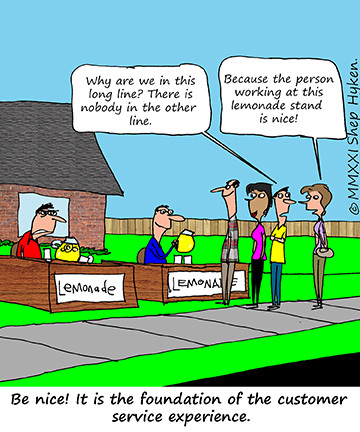 I’ve written about today’s topic before. The idea I’m about to share is really common sense. Even if you didn’t read my past articles or watch my videos about this, you still know and understand it. Yet, it’s worth bringing up again, as I have a new twist on it.
I’ve written about today’s topic before. The idea I’m about to share is really common sense. Even if you didn’t read my past articles or watch my videos about this, you still know and understand it. Yet, it’s worth bringing up again, as I have a new twist on it.
In my latest book, I’ll Be Back: How to Get Customers to Come Back Again and Again, I share a story about the shortest customer service keynote speech I’ve ever delivered. The short version of this story is that I was the closing keynote speaker. The client said, “You have to end on time, no matter what time you start.” I accepted the challenge and as we got closer to the time, I realized that the speakers ahead of me were going long. By the time it was my turn to walk on stage, I had just two minutes.
Two minutes! What can you say in two minutes? How could you warm up the audience in two minutes, let alone deliver a speech? I told my client, “I’ve got this.”
I walked on stage and informed the audience that my original speech was much longer, but I promised the client that I would end on time. I said something like, “So imagine I was just introduced. You applauded and I took center stage. Okay, here goes. The shortest customer service speech ever …
“BE NICE!”
And with that, I headed off stage. I stopped a few feet short of the steps and turned around to face the audience. After all, I still had about a minute left. I informed them that being nice is the backbone of the customer experience and that it’s common sense. After another brief comment or two, I exited the stage – in just under two minutes.
Now, the idea of being nice is ridiculously simple. But have you ever reached out to a company and its employee had the right answer, but an attitude that was negative or indifferent? Even with the right answer, without being nice, it was at best a bittersweet experience.
Being nice is so simple and easy. There’s no excuse not to be nice. It may appear to be of minor importance, but don’t be fooled. It’s more important than you think.
I compare being nice to the dishwasher in a restaurant. It doesn’t matter how wonderful the chef’s meal is, if it comes out on a dirty plate, it’s going back to the kitchen. And, if there aren’t any clean dishes, the food can’t even be served to the guest.
Being nice is like that dishwasher. Without this rudimentary concept, your best efforts in providing the customer a good experience are tainted.
While this may not seem like an important lesson, it is. Never overlook the power of being nice!
Shep Hyken is a customer service expert, keynote speaker, and New York Times, bestselling business author. For information on The Customer Focus customer service training programs, go to www.thecustomerfocus.com. Follow on Twitter: @Hyken
customer service training programs, go to www.thecustomerfocus.com. Follow on Twitter: @Hyken
(Copyright © MMXXI, Shep Hyken)
The post The Shortest Customer Service Keynote Speech Ever! appeared first on Shep Hyken.





